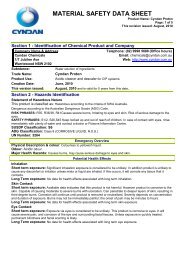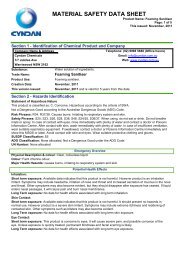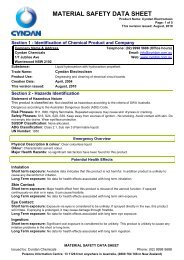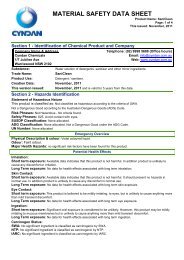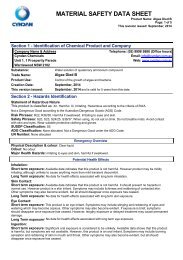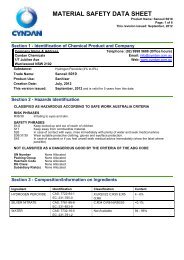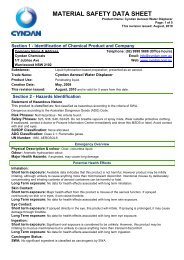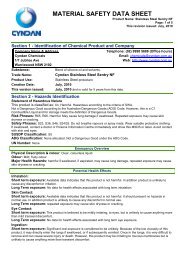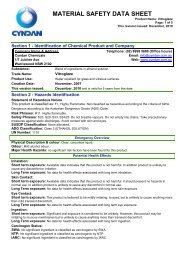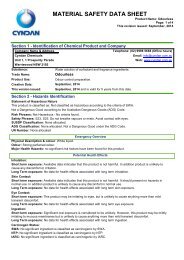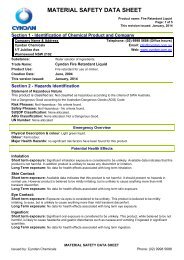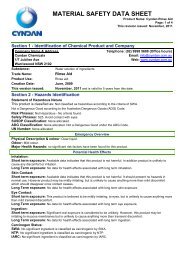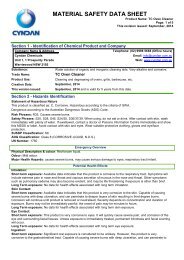Sizzla - MSDS - CYNDAN Chemicals
Sizzla - MSDS - CYNDAN Chemicals
Sizzla - MSDS - CYNDAN Chemicals
Create successful ePaper yourself
Turn your PDF publications into a flip-book with our unique Google optimized e-Paper software.
Product Name: <strong>Sizzla</strong><br />
Page: 2 of 4<br />
This revision issued: November, 2012<br />
Section 3 - Composition/Information on Ingredients<br />
Ingredients CAS No Conc,% TWA (mg/m 3 ) STEL (mg/m 3 )<br />
Non hazardous detergents various 1-5 not set not set<br />
Non hazardous organic acids various 60-65 not set not set<br />
Other non hazardous ingredients various 1-5 not set not set<br />
Water 7732-18-5 to 100 not set not set<br />
This is a commercial product whose exact ratio of components may vary slightly. Minor quantities of other non<br />
hazardous ingredients are also possible.<br />
The SWA TWA exposure value is the average airborne concentration of a particular substance when calculated over a normal 8 hour working day<br />
for a 5 day working week. The STEL (Short Term Exposure Limit) is an exposure value that may be equalled (but should not be exceeded) for no<br />
longer than 15 minutes and should not be repeated more than 4 times per day. There should be at least 60 minutes between successive exposures<br />
at the STEL. The term "peak "is used when the TWA limit, because of the rapid action of the substance, should never be exceeded, even briefly.<br />
Section 4 - First Aid Measures<br />
General Information:<br />
You should call The Poisons Information Centre if you feel that you may have been poisoned, burned or irritated by<br />
this product. The number is 13 1126 from anywhere in Australia (0800 764 766 in New Zealand) and is available at all<br />
times. Have this <strong>MSDS</strong> with you when you call.<br />
Inhalation: First aid is not generally required. If in doubt, contact a Poisons Information Centre or a doctor.<br />
Skin Contact: Irritation is unlikely. However, if irritation does occur, flush with lukewarm, gently flowing water for 5<br />
minutes or until chemical is removed.<br />
Eye Contact: No effects expected. If irritation does occur, flush contaminated eye(s) with lukewarm, gently flowing<br />
water for 5 minutes or until the product is removed. Obtain medical advice if irritation becomes painful or lasts more<br />
than a few minutes. Take special care if exposed person is wearing contact lenses.<br />
Ingestion: If product is swallowed or gets in mouth, do NOT induce vomiting; wash mouth with water and give some<br />
water to drink. If symptoms develop, or if in doubt contact a Poisons Information Centre or a doctor.<br />
Section 5 - Fire Fighting Measures<br />
Fire and Explosion Hazards: There is no risk of an explosion from this product under normal circumstances if it is<br />
involved in a fire.<br />
This product is likely to decompose only after heating to dryness, followed by further strong heating.<br />
Fire decomposition products from this product are likely to be irritating if inhaled.<br />
Extinguishing Media: Not Combustible. Use extinguishing media suited to burning materials.<br />
Fire Fighting: If a significant quantity of this product is involved in a fire, call the fire brigade.<br />
Flash point:<br />
Does not burn.<br />
Upper Flammability Limit: Does not burn.<br />
Lower Flammability Limit:<br />
Autoignition temperature:<br />
Flammability Class:<br />
Does not burn.<br />
Not applicable - does not burn.<br />
Does not burn.<br />
Section 6 - Accidental Release Measures<br />
Accidental release: Minor spills do not normally need any special cleanup measures. In the event of a major spill,<br />
prevent spillage from entering drains or water courses. As a minimum, wear overalls, goggles and gloves. Suitable<br />
materials for protective clothing include rubber, PVC. Eye/face protective equipment should comprise as a minimum,<br />
protective glasses and, preferably, goggles.<br />
Stop leak if safe to do so, and contain spill. Absorb onto sand, vermiculite or other suitable absorbent material. If spill<br />
is too large or if absorbent material is not available, try to create a dike to stop material spreading or going into drains<br />
or waterways. Sweep up and shovel or collect recoverable product into labelled containers for recycling or salvage,<br />
and dispose of promptly. Recycle containers wherever possible after careful cleaning. After spills, wash area<br />
preventing runoff from entering drains. If a significant quantity of material enters drains, advise emergency services.<br />
This material may be suitable for approved landfill. Ensure legality of disposal by consulting regulations prior to<br />
disposal. Thoroughly launder protective clothing before storage or re-use. Advise laundry of nature of contamination<br />
when sending contaminated clothing to laundry.<br />
Section 7 - Handling and Storage<br />
Handling: Keep exposure to this product to a minimum, and minimise the quantities kept in work areas. Check<br />
Section 8 of this <strong>MSDS</strong> for details of personal protective measures, and make sure that those measures are followed.<br />
The measures detailed below under "Storage" should be followed during handling in order to minimise risks to<br />
MATERIAL SAFETY DATA SHEET<br />
Issued by: Cyndan <strong>Chemicals</strong> Phone: (02) 9998 5688<br />
Poisons Information Centre: 13 1126 from anywhere in Australia, (0800 764 766 in New Zealand)



